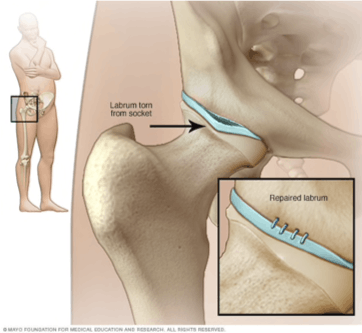By: Samantha Crisafulli, PT, DPT
Have you ever had intense groin pain after physical activity, or a constant feeling of a "catch" or "click" in your hip as you're walking? Often times, when going to a doctor, this can be misdiagnosed as a groin strain or pulled groin. When it may in fact be a labral tear in your hip. So, how can you know?
The hip is classified as a ball-and-socket joint where the socket is the acetabulum and the ball is the femoral head, or top of the femur (leg bone). A hip labral tear is an injury to the labrum, which is the soft tissue that covers the acetabulum. The labrum helps the femoral head move smoothly within the socket letting your hip move without pain.


There are many reasons that can lead to a hip labral tear, including:
- Injury: Trauma to the hip while participating in repetitive, high-impact sports or movements.
- Structural ailments: Conditions that cause abnormal hip movement such as impingement, where the femoral head doesn't fit into the socket properly. This can also occur from osteoarthritis.
- Degenerative health conditions: Osteoarthritis or other chronic wearing down of the cartilage between the joints. Older age or excessive weight can increase a person's risk for developing osteoarthritis.
Symptoms of a hip labral tear include:
- Hip pain or stiffness
- Pain in the groin or buttocks region
- A clicking or locking sound when moving
- Feeling unsteady or as if your leg is going to give out
If you are experiencing one or more of these symptoms, visit your primary care practitioner! They will most likely schedule you for an MRI and refer you to a physical therapist at Professional Rehabilitation Services (PRS). Here, your PT will perform a mechanical and musculoskeletal examination of your back and hip to determine the extent of the condition and the potential for rehabilitation. Treatment thereafter will consist of soft tissue mobilization, passive stretching, range of motion and therapeutic exercises, all with the goal of improving hip mobility, flexibility and strength to allowing you to return to daily activities with decreased compensation and pain.
At Professional Rehabilitation Services, we treat a wide variety of musculoskeletal and neurological conditions using the latest in evidence-based therapies provided by highly credentialed physical therapists. Professional Rehabilitation Services has eight convenient locations in Pawleys Island, Murrells Inlet, Surfside Beach, Market Common, Myrtle Beach, Carolina Forest, Conway, and Little River.
For further information on this or other related topics you can contact Richard DeFalco, DPT, OCS, CSCS, CWcHP at Professional Rehabilitation Services (Myrtle Beach) (843) 839-1300, Brian P. Kinmartin PT, DPT, MTC, STC, OCS, CWcHP (Pawleys Island) (843) 235-0200, Richard A. Owens, MPT, OCS, Cert. SMT, CWcHP (Surfside) (843) 831-0163, Jill P. Phelan, PT, DPT, Cert. DN (Conway) (843) 773-3031, Lisa O'Brien, PT, DPT, Cert. DN (Murrells Inlet) (843) 314-3224, Karl Ehlers, PT, DPT, Cert. DN (Little River) (843) 281-4222, Samantha Crisafulli PT, DPT (Carolina Forest) (843) 282-0440, Zach Daniels PT, DPT (Market Commons) (843) 213-6338 or visit our website at www.prsrehabservices.com where you can learn more about the company and even download a referral form for your physician to fill out. You can also call and schedule a< free 15-minute consultation.
